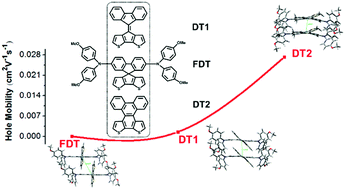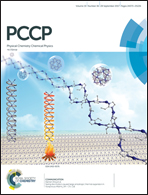Theoretical insights into the effect of a conjugated core on the hole transport properties of hole-transporting materials for perovskite solar cells†
Abstract
Conjugated bifluorenylidene and naphthalene central cores are introduced into hole-transporting materials DT1 and DT2 to replace the spiro-core of the reported, highly efficient FDT. The effects of the conjugated core on the geometrics, electronic properties and hole transport properties are investigated by using density functional theory coupled with Marcus theory and the Einstein relation. The calculated results show that DT1 (−5.21 eV) and DT2 (−5.23 eV) have lower HOMO levels than FDT (−5.15 eV), which indicates that the perovskite solar cells with conjugated hole-transporting materials can have higher open-circuit voltages. The introduction of the conjugated core is beneficial to the more efficient face-to-face packing pattern of the dimer, resulting in a larger intermolecular electronic coupling. Importantly, it is found that DT1 (1.6 × 10−3 cm2 V−1 s−1) and DT2 (2.7 × 10−2 cm2 V−1 s−1) exhibit relatively higher hole mobilities than FDT (1.3 × 10−4 cm2 V−1 s−1) owing to the larger electronic coupling. Therefore, enhanced hole transport ability can be achieved by switching from the spiro-core to the conjugated core. The present work provides a new strategy to improve the hole transport properties of hole-transporting materials, which will contribute to the development of conjugated small molecules as hole-transporting materials in efficient perovskite solar cells.

- This article is part of the themed collection: 2017 PCCP HOT Articles


 Please wait while we load your content...
Please wait while we load your content...